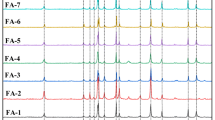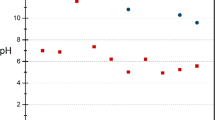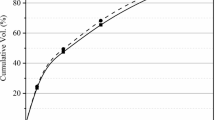Abstract
With proper leaching tests, health hazards associated with municipal solid waste incineration (MSWI) ashes, i.e., incineration bottom ashes (IBA) and incineration fly ashes (IFA), can be quantitatively defined. However, it must be coupled with specific environmental scenarios to draw the proper conclusions. Several environmental stresses based on current management of MSWI ashes were herein simulated with laboratory leaching studies to understand their impacts. The impact of bulk metal recovery on the IBA leaching potential was firstly investigated, suggesting the promoted release for certain metals including those with a relative high content (> 1000 mg/kg) such as Ba, Cu, Pb and Zn. The impact of seawater was also simulated. Most metal release was altered with the new chemistry established. Batch leaching tests were further performed under both salty and acidic environment to understand their aggregated effects, indicating an overwhelming influence from seawater buffering. Lastly, batch leaching tests of the IBA/IFA mixture were performed under various mass ratios, while data were compared with those by their individuals and the theoretical leaching value, unveiling different leaching characteristics during landfill disposal. Hereby, a comprehensive characteristic metal leaching potential was achieved under various ash managements. It provides insights into environmental risks relevant to their current practices.





Similar content being viewed by others
Abbreviations
- MSWI:
-
Municipal solid waste incineration
- IBA:
-
Incineration bottom ashes
- IFA:
-
Incineration fly ashes
- IA:
-
Incineration ashes
- TCLP:
-
Toxicity characteristic leaching potential
- WTE:
-
Waste-to-energy
- DI:
-
Deionized
- MSW:
-
Municipal solid waste
- MR:
-
Metal recovery
- ESP:
-
Electrostatic precipitator
- APC:
-
Air pollution control
- LOI:
-
Loss on ignition
- TC:
-
Total carbon
- TOC:
-
Total organic carbon
- ICP-OES:
-
Inductively coupled plasma-optical emission spectrometer
- ICP-MS:
-
Inductively coupled plasma-mass spectrometer
- IC:
-
Ion chromatography
- IBA5:
-
IBA combination sample made of all collection in 5 months
- IBA3:
-
IBA combination sample made of all collection in 3 months (the 2–4th months)
References
Dou X, Ren F, Nguyen MQ, Ahamed A, Yin K, Chan WP, Chang VW-C (2017) Review of MSWI bottom ash utilization from perspectives of collective characterization, treatment and existing application. Renew Sustain Energy Rev 79:24–38
Kuo W-T, Liu C-C, Su D-S (2013) Use of washed municipal solid waste incinerator bottom ash in pervious concrete. Cem Concr Compos 37:328–335
Pera J, Coutaz L, Ambroise J, Chababbet M (1997) Use of incinerator bottom ash in concrete. Cem Concr Res 27:1–5
Siddique R (2010) Use of municipal solid waste ash in concrete. Resour Conserv Recy 55:83–91
Weng M-C, Lin C-L, Ho C-I (2010) Mechanical properties of incineration bottom ash: the influence of composite species. Waste Manage (Oxford) 30:1303–1309
Yin K, Tong H, Giannis A, Chang VW-C, Wang J-Y (2016) Insights for transformation of contaminants in leachate at a tropical landfill dominated by natural attenuation. Waste Manage (Oxford) 53:105–115
Birgisdóttir H, Bhander G, Hauschild MZ, Christensen TH (2007) Life cycle assessment of disposal of residues from municipal solid waste incineration: recycling of bottom ash in road construction or landfilling in Denmark evaluated in the ROAD-RES model. Waste Manage (Oxford) 27:S75–S84
Van Gerven T, Van Keer E, Arickx S, Jaspers M, Wauters G, Vandecasteele C (2005) Carbonation of MSWI-bottom ash to decrease heavy metal leaching, in view of recycling. Waste Manage (Oxford) 25:291–300
Lin S, Zhou X, Ge L, Ng SH, Zhou X, Chang VWC (2016) Development of an accelerated leaching method for incineration bottom ash correlated to toxicity characteristic leaching protocol. Electrophoresis 37:2458–2461
Su L, Guo G, Shi X, Zuo M, Niu D, Zhao A, Zhao Y (2013) Copper leaching of MSWI bottom ash co-disposed with refuse: effect of short-term accelerated weathering. Waste Manage (Oxford) 33:1411–1417
Lin WY, Heng KS, Nguyen MQ, Ho JRI, Mohamed Noh OAB, Zhou XD, Liu A, Ren F, Wang J-Y (2017) Evaluation of the leaching behavior of incineration bottom ash using seawater: a comparison with standard leaching tests. Waste Manage (Oxford) 62:139–146
Bruder-Hubscher V, Lagarde F, Leroy MJF, Coughanowr C, Enguehard F (2002) Application of a sequential extraction procedure to study the release of elements from municipal solid waste incineration bottom ash. Anal Chim Acta 451:285–295
Forteza R, Far M, Seguı́ C, Cerdá V (2004) Characterization of bottom ash in municipal solid waste incinerators for its use in road base. Waste Manage (Oxford) 24:899–909
Yin K, Dou X, Ren F, Chan W-P, Chang VW-C (2018) Statistical comparison of leaching behavior of incineration bottom ash using seawater and deionized water: significant findings based on several leaching methods. J Hazard Mater 344:635–648
Agcasulu I, Akcil A (2017) Metal recovery from bottom ash of an incineration plant: laboratory reactor tests. Miner Process Extr Metall Rev 38:199–206
Oehmig WN, Roessler JG, Zhang J, Townsend TG (2015) Effect of ferrous metal presence on lead leaching in municipal waste incineration bottom ashes. J Hazard Mater 283:500–506
Sivula L, Sormunen K, Rintala J (2012) Leachate formation and characteristics from gasification and grate incineration bottom ash under landfill conditions. Waste Manage (Oxford) 32:780–788
Fan H-c, Yu J, Chen R-p, Yu L (2019) Preparation of a bioflocculant by using acetonitrile as sole nitrogen source and its application in heavy metals removal. J Hazard Mater 363:242–247
Inanc B, Inoue Y, Yamada M, Ono Y, Nagamori M (2007) Heavy metal leaching from aerobic and anaerobic landfill bioreactors of co-disposed municipal solid waste incineration bottom ash and shredded low-organic residues. J Hazard Mater 141:793–802
Klein R, Baumann T, Kahapka E, Niessner R (2001) Temperature development in a modern municipal solid waste incineration (MSWI) bottom ash landfill with regard to sustainable waste management. J Hazard Mater 83:265–280
Yao J, Kong Q, Li W, Zhu H, Shen D-S (2014) Effect of leachate recirculation on the migration of copper and zinc in municipal solid waste and municipal solid waste incineration bottom ash co-disposed landfill. J Mater Cycles Waste Manag 16:775–783
Chan JKH (2016) The ethics of working with wicked urban waste problems: the case of Singapore’s Semakau Landfill. Landsc Urban Plan 154:123–131
Yin K, Chan WP, Dou X, Ren F, Chang VW-C (2017) Measurements, factor analysis and modeling of element leaching from incineration bottom ashes for quantitative component effects. J Clean Prod 165:477–490
You GS, Ahn JW, Han GC, Cho HC (2006) Neutralizing capacity of bottom ash from municipal solid waste incineration of different particle size. Korean J Chem Eng 23:237–240
Phongphiphat A, Ryu C, Finney KN, Sharifi VN, Swithenbank J (2011) Ash deposit characterisation in a large-scale municipal waste-to-energy incineration plant. J Hazard Mater 186:218–226
Bureau EI (2005) Reference document on the best available techniques for waste incineration in EU, Brussels
Guimaraes AL, Okuda T, Nishijima W, Okada M (2006) Organic carbon leaching behavior from incinerator bottom ash. J Hazard Mater 137:1096–1101
Wiles CC (1996) Municipal solid waste combustion ash: state-of-the-knowledge. J Hazard Mater 47:325–344
Quenee B, Li G, Siwak JM, Basuyau V (2000) The use of MSWI (Municipal solid waste incineration) bottom ash as aggregates in hydraulic concrete. In: G.R. Woolley JJJMG, Wainwright PJ (eds) Waste Management Series, Elsevier, pp 422-437
Zekkos D, Kabalan M, Syal SM, Hambright M, Sahadewa A (2013) Geotechnical characterization of a municipal solid waste incineration ash from a Michigan monofill. Waste Manage (Oxford) 33:1442–1450
Grosso M, Biganzoli L, Rigamonti L (2011) A quantitative estimate of potential aluminium recovery from incineration bottom ashes. Resour Conserv Recy 55:1178–1184
Jung CH, Matsuto T, Tanaka N, Okada T (2004) Metal distribution in incineration residues of municipal solid waste (MSW) in Japan. Waste Manage (Oxford) 24:381–391
Li W, Ma Z, Huang Q, Jiang X (2018) Distribution and leaching characteristics of heavy metals in a hazardous waste incinerator. Fuel 233:427–441
Yin K, Li P, Chan WP, Dou X, Wang J-Y (2018) Characteristics of heavy metals leaching from MSWI fly ashes in sequential scrubbing processes. J Mater Cycles Waste Manag 20:604–613
Huang W-J (2008) Optimization of sprayed lime amount in the semi-dry scrubbing system of MSWI. Waste Manage (Oxford) 28:2403–2405
Billen P, Verbinnen B, De Smet M, Dockx G, Ronsse S, Villani K, De Greef J, Van Caneghem J, Vandecasteele C (2015) Comparison of solidification/stabilization of fly ash and air pollution control residues from municipal solid waste incinerators with and without cement addition. J Mater Cycles Waste Manage 17:229–236
Nilsson M, Andreas L, Lagerkvist A (2016) Effect of accelerated carbonation and zero valent iron on metal leaching from bottom ash. Waste Manage (Oxford) 51:97–104
Olsson S, Gustafsson JP, Berggren Kleja D, Bendz D, Persson I (2009) Metal leaching from MSWI bottom ash as affected by salt or dissolved organic matter. Waste Manage (Oxford) 29:506–512
Mitrano D, Mehrabi K, Dasilva YAR, Nowack B (2017) Mobility of metallic (nano)particles in leachates from landfills containing waste incineration residues. Environ Sci Nano 4:480–492
Zhang H, He P-J, Shao L-M, Li X-J (2008) Leaching behavior of heavy metals from municipal solid waste incineration bottom ash and its geochemical modeling. J Mater Cycles Waste Manage 10:7–13
Sawell SE, Bridle TR, Constable TW (1988) Heavy metal leachability from solid waste incinerator ashes. Waste Manage Res 6:227–238
Hyks J, Astrup T (2009) Influence of operational conditions, waste input and ageing on contaminant leaching from waste incinerator bottom ash: a full-scale study. Chemosphere 76:1178–1184
Hain M, Sigman D, Higgins J, Haug G (2015) The effects of secular calcium and magnesium concentration changes on the thermodynamics of seawater acid/base chemistry: implications for Eocene and Cretaceous ocean carbon chemistry and buffering. Global Biogeochem Cycles 29:517–533
Yin K, Chan W-P, Dou X, Lisak G, Chang VW-C (2018) Co-complexation effects during incineration bottom ash leaching via comparison of measurements and geochemical modeling. J Clean Prod 189:155–168
Bendz D, Tüchsen PL, Christensen TH (2007) The dissolution kinetics of major elements in municipal solid waste incineration bottom ash particles. J Contam Hydrol 94:178–194
Inkaew K, Saffarzadeh A, Shimaoka T (2016) Modeling the formation of the quench product in municipal solid waste incineration (MSWI) bottom ash. Waste Manage (Oxford) 52:159–168
Smith RW (1991) Recalculation, evaluation, and prediction of surface complexation constants for metal adsorption on iron and manganese oxides. Environ Sci Technol 25:525–531
Hsia TH (1992) Interaction of Cr(VI) with amorphous iron oxide: adsorption density and surface charge. Water Sci Technol 26:181–188
Liikanen M, Havukainen J, Hupponen M, Horttanainen M (2017) Influence of different factors in the life cycle assessment of mixed municipal solid waste management systems—A comparison of case studies in Finland and China. J Clean Prod 154:389–400
Li W-B, Yao J, Malik Z, Zhou G-D, Dong M, Shen D-S (2014) Impact of MSWI bottom ash codisposed with MSW on landfill stabilization with different operational modes. Biomed Res Int 2014:10
Akinyemi SA, Akinlua A, Gitari WM, Khuse N, Eze P, Akinyeye RO, Petrik LF (2012) Natural weathering in dry disposed ash dump: insight from chemical, mineralogical and geochemical analysis of fresh and unsaturated drilled cores. J Environ Manage 102:96–107
Ahmed A, Khalid H, Chen D (2010) A lysimeter experimental study and numerical characterisation of the leaching of incinerator bottom ash waste. Waste Manage (Oxford) 30:1536–1543
Ecke H, Åberg A (2006) Quantification of the effects of environmental leaching factors on emissions from bottom ash in road construction. Sci Total Environ 362:42–49
Ludwig B, Khanna P, Prenzel J, Beese F (2005) Heavy metal release from different ashes during serial batch tests using water and acid. Waste Manage (Oxford) 25:1055–1066
Viana PZ, Yin K, Rockne KJ (2008) Modeling active capping efficacy. 1. Metal and organometal contaminated sediment remediation. Environ Sci Technol 42:8922–8929
Bayuseno AP, Schmahl WW (2010) Understanding the chemical and mineralogical properties of the inorganic portion of MSWI bottom ash. Waste Manage (Oxford) 30:1509–1520
Saffarzadeh A, Shimaoka T, Wei Y, Gardner KH, Musselman CN (2011) Impacts of natural weathering on the transformation/neoformation processes in landfilled MSWI bottom ash: a geoenvironmental perspective. Waste Manage (Oxford) 31:2440–2454
Wang Y, Shao Y, Matovic MD, Whalen JK (2016) Recycling combustion ash for sustainable cement production: a critical review with data-mining and time-series predictive models. Constr Build Mater 123:673–689
Shi C, Day RL (2000) Pozzolanic reaction in the presence of chemical activators: part II—Reaction products and mechanism. Cem Concr Res 30:607–613
Acknowledgements
The authors would like to thank National Environmental Agency, Singapore for financially supporting this work.
Author information
Authors and Affiliations
Corresponding authors
Additional information
Publisher's Note
Springer Nature remains neutral with regard to jurisdictional claims in published maps and institutional affiliations.
Electronic supplementary material
Below is the link to the electronic supplementary material.
Rights and permissions
About this article
Cite this article
Yin, K., Dou, X., Chan, WP. et al. Comparative leaching characteristics of fly/bottom ashes from municipal solid waste incineration under various environmental stresses. J Mater Cycles Waste Manag 22, 46–55 (2020). https://doi.org/10.1007/s10163-019-00915-4
Received:
Accepted:
Published:
Issue Date:
DOI: https://doi.org/10.1007/s10163-019-00915-4




